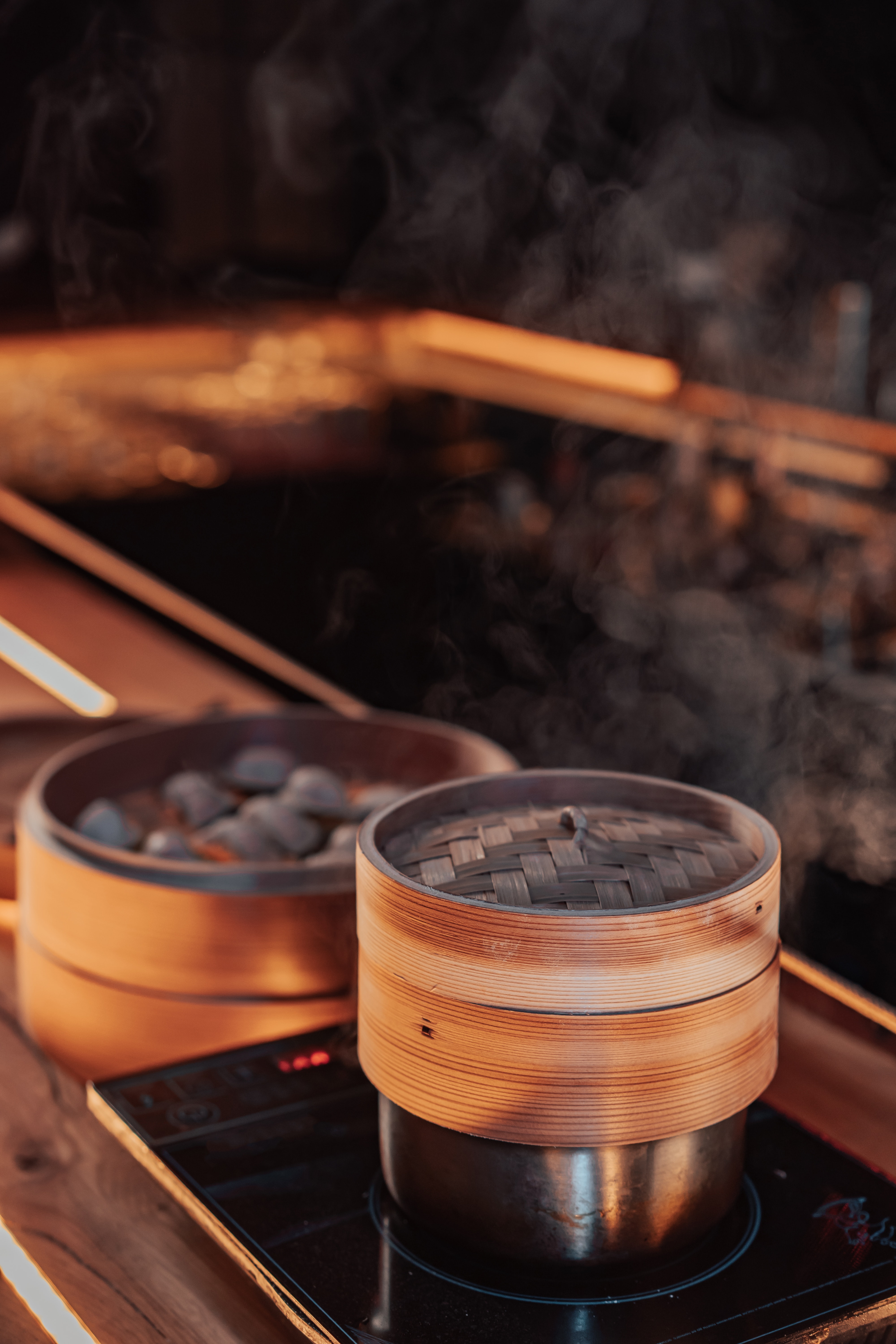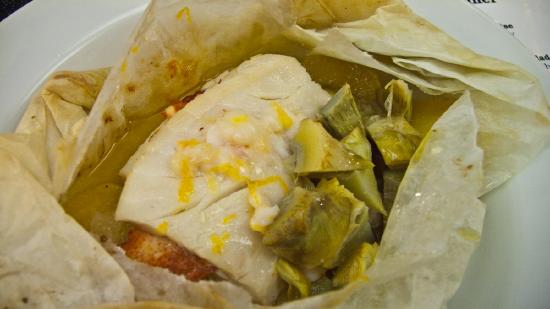1.2.7: The Cooking Techniques -Moist Heat
- Page ID
- 64423
Moist Heat Cooking Methods:
Cooking with moist heat means that the food is being heated or cooked by water or some other liquid. Liquids other than water may include broth, stocks, or milk etc. Liquid used during the cooking process is responsible for not only the process of cooking itself but can be an opportunity to add flavor. Moist heat is the preferred method of cooking for tougher, less tender cuts of beef (e.g. flank steak) as it breaks down and softened the fibrous proteins. Moist heat is also used when cooking vegetables because moisture is able to break down the cellulose walls of the vegetables themselves.
Moist heat, especially in the case of vegetables, can alter the color making it less appealing and is known to reduce the water-soluble nutrient content of the food. Ways to combat the loss of nutrients is to cook vegetables for the shortest amount of time possible. Color can be maintained through a process called blanching" and by cooking these vegetables in smaller batches and on "as-needed" basis.
Types of moist heat cooking methods include:
- Scalding
- Poaching
- Simmering
- Stewing
- Braising
- Boiling
- Steaming
- Microwaving
Scalding:
Scalding is a technique that has historically been applied to milk, before the process of pasteurization, to kill bacteria. These days, scalding milk is not often necessary but involves heating the liquid to a temperature of 150 ˚F. There may be bubbles present along the sides of the pan but not throughout the liquid.
Poaching:
Have you ever poached an egg to make Eggs Benedict? Poached pears in wine for dessert? Delicately cooked a fish covered with water, stock or wine (poaching liquids) in a covered pan to preserve the moistness of the meat. These are examples of poaching you are probably familiar with.
It is the method accomplished with the least amount of heat, and, therefore is a gradual, gentle cooking process. Poaching is best for very delicate foods, such as eggs, fish, white meat chicken, and fruit. It is considered a healthy cooking method because liquid—not fat—carries the heat into the food.
Poaching is ideally done at temperatures between 160°F and 190°F, or well below a simmer. The best way to tell if a poaching liquid is at the correct temperature is with an instant-read thermometer.
Poaching takes patience. Poaching allows the proteins in foods to uncoil, or denature, slowly, without squeezing out moisture. If you were to drop a delicate chicken breast into boiling water, the proteins would seize up so quickly that all the moisture would be squeezed out, and you would end up with a small piece of dry rubber!
You can poach in water, milk or a flavorful broth. For dessert preparations, fruit is often poached in sweet wine and water with some spices Eggs are generally poached in water with a bit of vinegar. The acid in the poaching liquid helps to speed up the protein coagulation on the outside of the food.
.jpg?revision=1&size=bestfit&width=295&height=410)
Photo Courtesy of Marta Dzedysho on Pexels
Simmering:
You may be familiar with the term simmering already as it is frequently used in many recipes when the temperature is turned down to a "simmer" and food is allowed to cook at a lower temperature for a longer duration of time. Simmering is characterized by the presence of gentle bubbles that barely break the surface of the liquid. Simmering is often preferred over boiling because it can reduce the amount of damage to the appearance of food and when cooking tougher meats the slower cooking method helps the meat become more tender.
Photo Courtesy of Anna Tarazevich from Pexels
Stewing:
Stewing is essentially a type of simmering that uses a small to moderate amount of water (or other cooking liquid). Stews often consist of chopped up meats and vegetables cooked in a flavorful broth or liquid. The chopped ingredients are typically added to a large pot with just enough liquid to cover them then brought to a simmer and covered with a lid. With recipes are stewed, the liquid is not drained away.
Photo Courtesy of Klaus Nielson from Pexels
Braising
Braising (from the French word braiser) is a combination-cooking method that uses both wet and dry heats: typically, the food is first sautéed or seared at a high temperature, then finished in a covered pot at a lower temperature while sitting in some (variable) amount of liquid (which may also add flavor). Braising of meat is often referred to as pot roasting, though some authors make a distinction between the two methods, based on whether additional liquid is added. Braising relies on heat, time, and moisture to break down the tough connective tissue (collagen) that binds together the muscle fibers collectively called "meat", making it an ideal way to cook tougher, more affordable cuts. Both pressure cooking, and slow cooking (e.g., crockpots) are forms of braising.
Most braises follow the same basic steps.
- The food to be braised (meats, vegetables, mushrooms, etc.) is first pan-seared to brown its surface and enhance its flavor (through the Maillard reaction).
- If the food will not produce enough liquid of its own, a certain amount of cooking liquid that often includes an acidic element (e.g., tomatoes, beer, balsamic vinegar, wine) is added to the pot, often with stock. A classic braise is done with a relatively whole cut of meat, and the braising liquid will cover one-third to one-half of the food in the pan.
- The dish is then covered and cooked at a very low simmer until the meat becomes so tender that it can be "cut" with just the gentlest of pressure from a fork (versus a knife).
- Often the cooking liquid is finished to create a sauce or gravy as well.
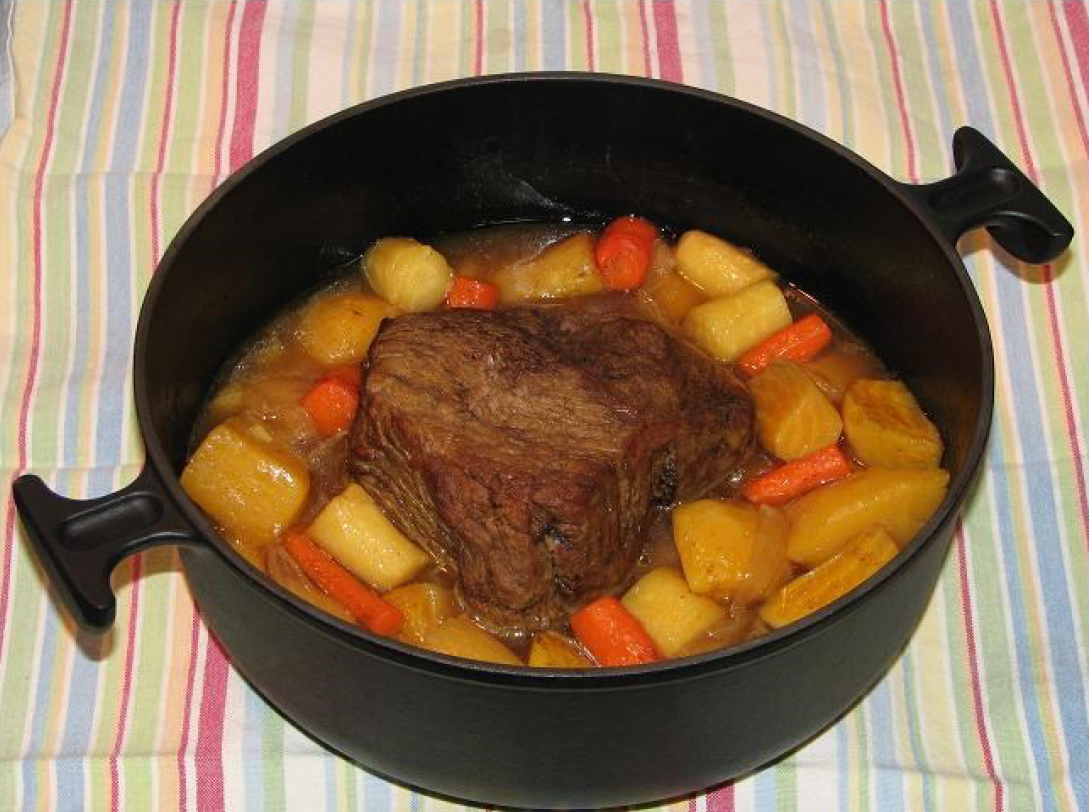
Pot Roast. Wikipedia. Commons cc-by 3.0
Boiling
In order to boil, water must reach a temperature of 212˚F or 100˚C. This temperature is only true at sea level and any change in elevation may affect the temperature at which water will boil. The addition of salt or sugar to the water may also affect the temperature at which water will boil, however, the average recipe does not contain enough of either to make meaningful or noticeable shifts. The higher temperature will result in larger bubbles that quickly rise to the surface of the liquid. Sometimes described as a "rolling boil" due to the visual agitation of the water when it has reached boiling point.
Boiling is often used to cook dry pasta, beans, and tough vegetables such as potatoes.
Parboiling: is a technique often used in restaurants or quick service establishments because it can greatly reduce the amount of time the customer is waiting for their meal to be prepared. Parboiling is essentially pre-cooking a food item in advance and finishing later. A good example of this is the product "Minute Rice". The reason this product can quickly cook in your home microwave in about a minute is due to the rice being parboiled beforehand, then dried and packaged for the homecook to finish the process at home.
Blanching: Blanching is another subset of boiling where food is quickly submerged in to boiling water. Blanching is utilized to set the color of green vegetables that otherwise would lose their bright green color in other cooking processes. Blanching may also be used to help remove the skin from tomatoes, shells from nuts, or in preparation for being canned or frozen.
Photo Courtesy of Antonius Ferret via Pexels Blanching- a.fiedler, CC BY-SA 2.0, via Wikimedia Commons
Steaming
Photo Courtesy of Mikhail Nilov from Pexels
When steaming, food is actually cooked at a higher temperature compared to poaching, braising, and stewing. Once water is heated past the 212°F mark, it stops being water and turns into steam. Steaming has an advantage over methods such as boiling or even simmering in that there is no agitation involved, so it is gentler on delicate items like seafood. Because it doesn't require the food to be submerged, it avoids the loss of nutrients through leaching. It also cooks relatively quickly.
Interestingly, steam's maximum temperature is also 212°F, just like water. However, unlike water, steam can be forced to exceed this natural temperature limit by pressurizing it. The higher the pressure, the hotter the steam becomes. Cooking with pressurized steam requires specialized equipment, though, which is typically not available to the beginner cook.
Steaming can be done on a stovetop with two simple pieces of equipment: a pot and a steamer basket. The pot is filled with a small amount of liquid that is brought to a simmer; the item to be cooked is placed in a basket suspended above the liquid, and the pot is then covered. The hot steam circulates through the pot and cooks the food very quickly. This technique is known as "compartment steaming." (The bamboo steamers used in Asian cuisine are an example of a compartment steamer.)
It is important that the bottom of the steamer basket does not touch the simmering water; this would add too much moisture to the vegetables and would not steam them correctly.
You can also steam food in the microwave, which is actually a natural piece of equipment for steaming since it "excites the liquids in food." You can create your own steaming system by placing the food in a microwave-safe dish, sprinkling it with water or other liquid, and covering it with plastic wrap with a few holes poked into it. Cook for just a few minutes and you will be rewarded with perfectly steamed food. You can also buy a steamer basket made just for the microwave if you find yourself using this method often.
Cooking en papillote: Another technique for cooking with steam is known as cooking EN PAPILLOTE ("in paper") or in packets. This method is frequently employed for cooking fish and involves enclosing the food in a pouch of parchment paper or aluminum foil along with a little liquid (often wine) and perhaps lemon, herbs, and even thinly sliced vegetables. The packet is then heated—in an oven or on a grill—so that the food inside cooks in its own steam.
En papillote edseloh, CC BY-SA 2.0, via Wikimedia Commons
Microwaving:
Microwaving technically operates by using both moist and dry heat methods but for the purpose of this class we will be discussing microwaving in this moist heat section. Microwaves work by agitating water molecules inside of the food being cooked and steam is produced in this process. It is a common misconception that microwaved food is cooked simply "from the inside out". Instead, when thicker foods are being cooked in the microwave, the outer layers are heated and cooked by the microwave ,and the inside is then cooked through the process of conduction.
Microwave cooking can be more energy efficient than other methods and can cut down on cooking time for many foods.
Sources:
fda.gov/radiation-emitting-products/resources-you-radiation-emitting-products/microwave-oven-radiation#:~:text=Microwaves%20are%20produced%20inside%20the,heat%20that%20cooks%20the%20food.
Brown. A. (2011). Understanding food principles and preparation 4th ed. Cengage Learning.



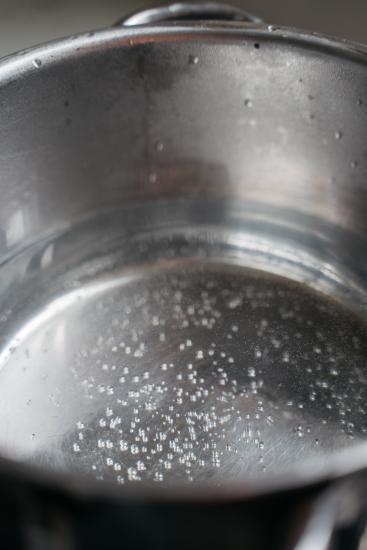
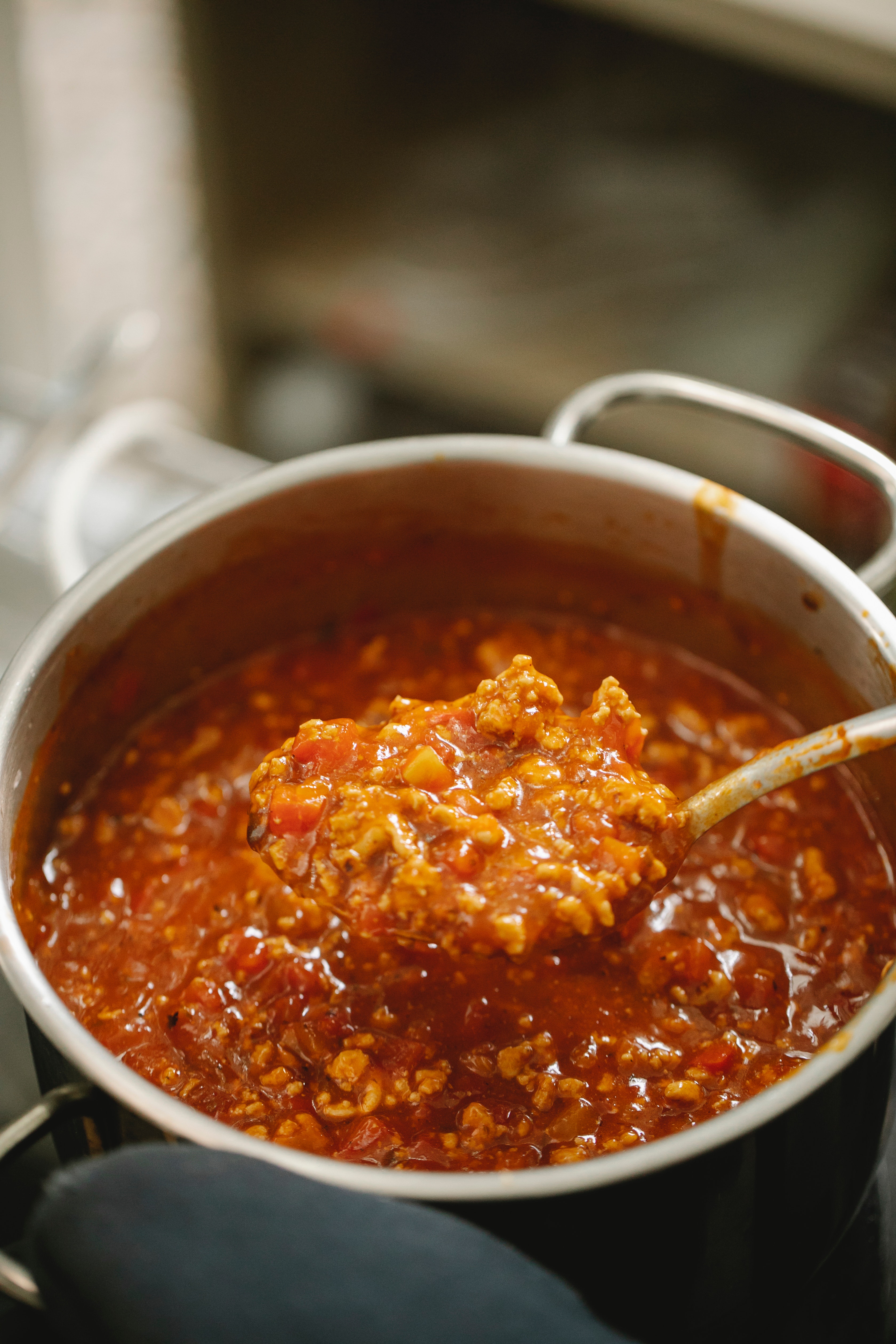
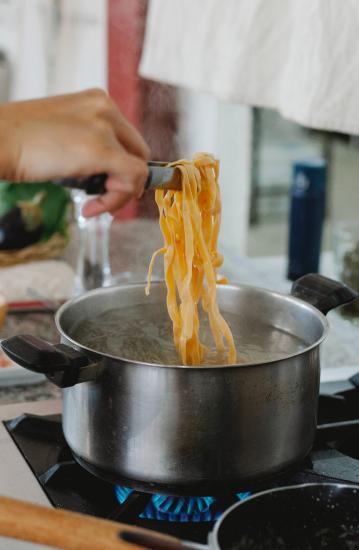
-01.jpg?revision=1)
